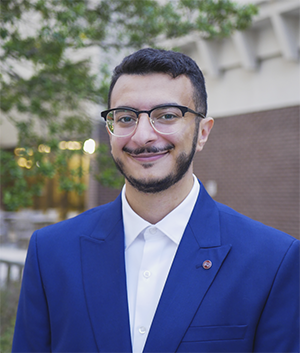by Hannah Buckelew
Ameer Mansur, a Ph.D. candidate in the laboratory of Anna Sorace, Ph.D., assistant professor in the UAB Department of Biomedical Engineering, has been awarded a pre-doctoral research training program (TL1) fellowship from the UAB Center for Clinical and Translational Science (CCTS), for his project, titled, “Prognostic biometric extraction of multiparametric imaging data in human epidermal growth factor receptor (HER2) positive breast cancer.” The fellowship is effective July 1, 2023 and will run through July 2024.
The TL1 Program allows fellows to develop projects focused on reducing health disparities that disproportionately affect the Deep South. In addition, TL1 recipients receive an NIH Ruth L Kirschstein National Research Service Award (NRSA) - a predoctoral stipend- for full-time multidisciplinary mentored research training.
“Through our research, we hope to optimize personalized care to each patient, thus improving outcomes for minority groups treated for HER2-positive breast cancer,” Mansur says.
His research focuses on extracting prognostic biometrics from multiparametric imaging data in the human epidermal growth factor receptor (HER2) positive breast cancer. The current study aims to determine the interplay of molecular markers and how combination therapy alters them. Although the proportions of HER2-positive breast cancer are comparable across ethnicities, the response to anti-HER2 treatment and its side effects are not.
“This disparity signifies the need for personalization of cancer treatments, considering factors such as socioeconomic status, household income, educational attainment, genetic mechanisms and underlying tumor biology,” Mansur says. “We want to include population-representative patients in our studies, ensuring our research and subsequent treatments cater to all demographics.”
Mansur will accomplish this specifically by quantifying sub regions of heterogeneity via histogram analysis of multiparametric qualitative PET/MRI clinical imaging by developing an automated clinical data processing workflow and applying it to multi-modality PET/MRI data. Mansur aims to examine tumoral habitat alterations with quantitative PET/MRI during combination targeted treatment in a patient derived xenograft (PDX) model of breast cancer. This will involve developing classification algorithms to cluster multiparametric tumor sub regions. This approach will quantitatively assess changes in regions of varying vascularity, cellularity, and proliferation in response to HER2 targeted treatments.
“Through our research, we hope to optimize personalized care to each patient, thus improving outcomes for minority groups treated for HER2-positive breast cancer,” Mansur says.
Mansur hopes to obtain his PhD in biomedical engineering to specialize in cancer image processing.
“Our ultimate goal is to contribute to the eradication of health disparities and the promotion of health equity.”
